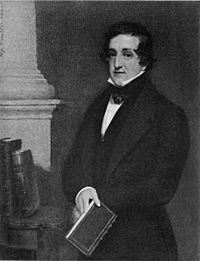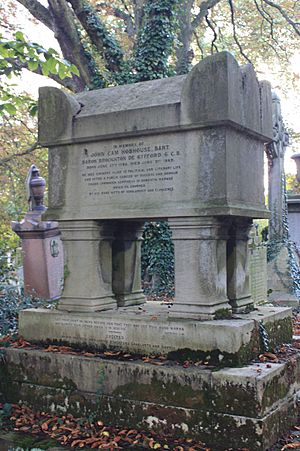John Hobhouse, 1st Baron Broughton facts for kids
Quick facts for kids
The Lord Broughton
|
|
|---|---|

Lord Broughton, from a miniature by Sir William Newton, R. A.
|
|
| President of the Board of Control | |
| In office 23 April 1835 – 30 August 1841 |
|
| Monarch | William IV Queen Victoria |
| Prime Minister | The Viscount Melbourne |
| Preceded by | The Lord Ellenborough |
| Succeeded by | The Lord Ellenborough |
| In office 8 July 1846 – 5 February 1852 |
|
| Monarch | Queen Victoria |
| Prime Minister | Lord John Russell |
| Preceded by | The Earl of Ripon |
| Succeeded by | Fox Maule |
| Personal details | |
| Born | 27 June 1786 Redland, near Bristol, England |
| Died | 3 June 1869 (aged 82) Berkeley Square, London, England |
| Political party | Whig |
| Spouse | Lady Julia Hay (d. 1835) |
| Alma mater | Trinity College, Cambridge |
John Cam Hobhouse, 1st Baron Broughton was an important English politician and writer. He was born on June 27, 1786, and passed away on June 3, 1869. He was also known as Sir John Hobhouse for many years before becoming Lord Broughton. He kept detailed diaries throughout his life.
Contents
Early Life and Education
John Cam Hobhouse was born in Redland, near Bristol, England. He was the oldest son of Sir Benjamin Hobhouse and Charlotte Cam.
He went to Westminster School for his early education. Later, he studied at Trinity College, Cambridge, and finished his studies in 1808. While at Cambridge, he won a special prize for his essay on sacrifices. He also helped start two student groups: the "Whig Club" and the "Amicable Society."
Friendship with Lord Byron and European Travels
At Cambridge, Hobhouse became close friends with the famous poet Lord Byron. In 1809, they traveled together through Spain, Greece, and Turkey.
Hobhouse also saw important historical events. He was present at the Battle of Dresden in August 1813. He then followed the armies into France and saw Louis XVIII enter Paris in May 1814.
In 1815, Hobhouse was in Paris again after Napoleon returned from Elba. He wrote a pamphlet showing his support for Napoleon and his dislike for the Bourbon kings. This pamphlet caused trouble in both England and France. The French government even seized the French translation and put the translator and printer in jail.
He traveled with Byron again later. Hobhouse wrote notes for Byron's famous poem, Childe Harold. Byron even dedicated a part of the poem to him. Hobhouse also shared Byron's dream of freeing Greece. After Byron died in 1824, Hobhouse helped with his will and funeral plans.
A Career in Parliament
In 1819, Hobhouse tried to become a Member of Parliament (MP) for Westminster. He was a candidate for the Radical party, which wanted big changes in government. He was already popular because he wrote about the need for reform. He famously said, "I am a man chosen for the people, by the people."
Later that year, he wrote a pamphlet that the House of Commons said was an attack on their power. He was arrested and stayed in Newgate prison for a few months. However, this only made him more popular. In the 1820 election, he was elected as an MP for Westminster.
In Parliament, Hobhouse was a strong supporter of reform. He is even credited with creating the phrase "His Majesty's (Loyal) Opposition" in 1826. This term describes the main political party that is not in power but still plays an important role.
In 1831, Hobhouse became the 2nd Baronet after his father passed away. In 1832, he was made secretary at war in the government led by Lord Grey. He made some good changes and saved money in this role. He also helped pass the Vestry Act 1831.
In March 1833, Hobhouse became Chief Secretary for Ireland. He resigned from this job and his seat in Parliament after only a few weeks. This was because he disagreed with the government on a tax issue. He lost the next election.
However, Hobhouse returned to government in July 1834. He became First Commissioner of Woods and Forests when Lord Melbourne became Prime Minister. Around the same time, he was elected as an MP for Nottingham. In Melbourne's government of 1835, he became President of the Board of Control. In this role, he strongly supported policies for India. He held this same position again in July 1846 in Lord John Russell's government.
In February 1851, Hobhouse became a member of the House of Lords as Baron Broughton. He left his government job when Lord Russell resigned in February 1852.
Later Life and Legacy
In 1852, Hobhouse received a high honor, becoming a Knight Grand Cross of the Order of the Bath (GCB). After this, he was less involved in politics. He spent his time on writing and corresponding with others.
Lord Broughton was also a partner in Whitbread's brewery. He was a member of the Royal Society and helped start the Royal Geographical Society. People who knew him said he was good at classical studies and a skilled debater, even if he wasn't the most exciting speaker.
Family Life
Lord Broughton married Lady Julia, the daughter of George Hay, 7th Marquess of Tweeddale, in 1828. They had three daughters. Sadly, Lady Julia passed away in April 1835.
John Cam Hobhouse died in London on June 3, 1869. Since he had no sons, his title as Baron Broughton ended when he died. His nephew, Charles Parry Hobhouse, inherited the baronetcy.
Works and Writings
John Cam Hobhouse wrote several important works during his life:
- He won a prize in 1808 for his essay on the Origin and Intention of Sacrifices.
- He wrote The substance of some letters written by an Englishman resident in Paris during the last reign of the emperor Napoleon in 1816.
- He published Historical illustrations of the fourth canto of "Childe Harold" containing dissertations on the ruins of Rome and an essay on Italian literature in 1818.
- He also wrote A defence of the People in reply to Lord Erskine's "Two Defences of the Whigs," and A trifling mistake in Thomas, Lord Erskine's recent preface in 1819.
He also kept many diaries and letters. These were kept private until 1900. Extracts from them were later published by his daughter, Lady Dorchester. A large collection of his writings is kept at the British Museum.


